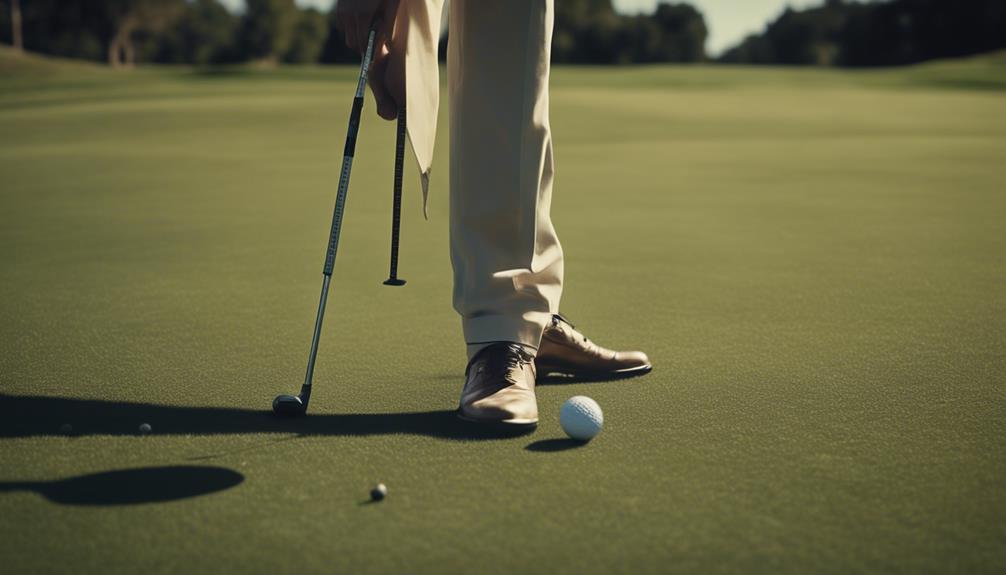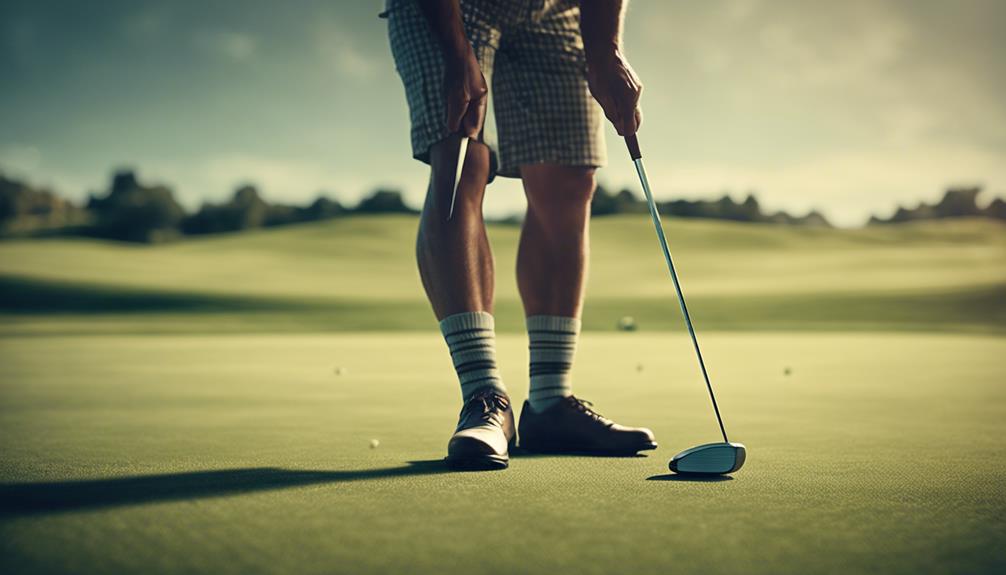- 7 Top Flite Golf Clubs XL for Improved Performance - September 28, 2024
- Top Flite Golf Clubs: Top 5 Reasons to Choose Them - September 28, 2024
- Top 3 Golf Club Fitters for a Perfect Swing - September 28, 2024
You're likely using golf clubs that are too long if you're struggling to maintain a consistent swing, feeling discomfort during play, or standing too far from the ball. Other signs include adopting an upright posture, improper swing mechanics, and inconsistent trajectory. If you're experiencing these issues, it's time to assess your club length. Measure your wrist-to-floor distance and overall height to determine your ideal club length. By doing so, you'll be one step closer to optimizing your game – and there's more to uncover about finding the perfect fit that can take your game to the next level.
Key Takeaways
- If you're struggling to maintain a consistent swing, your clubs might be too long, affecting your overall game performance.
- Discomfort during play or standing too far from the ball can indicate that your clubs are too long for your body.
- Adopting an upright posture or experiencing improper swing mechanics and inconsistent trajectory may signal that your clubs are too long.
- If you're sacrificing swing posture or comfort to accommodate your clubs, it's likely they're too long and need adjustment.
- Difficulty controlling the clubhead speed and direction can be a sign that your clubs are too long and require shortening for better control.
Determining Optimal Club Length
To determine your best club length, you'll need to take into account a combination of factors, including your height, arm length, and swing posture, as these physical characteristics directly impact your ability to swing a club efficiently and effectively.
Properly fitted golf clubs can greatly improve your overall game, and understanding how to determine the most suitable club length is vital. As a general rule, taller players require longer clubs, while shorter players need shorter clubs for a proper fit.
Professional club fitters use measurement techniques like overall height and wrist-to-floor measurement to determine club length. However, dynamic fitting, which involves evaluating a player's swing motion, provides a more precise assessment. This is because it takes into account the lie angle and swing posture, ensuring the club length aligns with your unique swing characteristics.
Signs of Clubs Being Too Long
If you're struggling to maintain a consistent swing and experiencing discomfort during play, it may be a sign that your golf clubs are too long for your body type and swing mechanics.
You may notice that you're standing too far from the ball, affecting your body rotation and power in the swing, or that you're adopting a completely upright posture to compensate for the extra length. This can lead to improper swing mechanics, resulting in inconsistent trajectory and poor ball striking.
Even if you're able to make solid contact, you may feel a little off-balance or uncomfortable, which can throw off your entire game. If you're experiencing consistent performance issues and discomfort, it may be worth examining your club length.
A club that's too long can feel heavy and cumbersome, slowing down your swing speed and making it difficult to achieve a proper stance. By recognizing these signs, you can take the first step towards finding a club that's tailored to your unique needs and swing style, allowing you to reveal your full potential on the course.
Measuring for the Right Fit

You'll need to take accurate measurements to determine the ideal club length for your swing, starting with the wrist-to-floor measurement that will serve as the foundation for finding the perfect fit.
To get a precise measurement, stand with your arms hanging straight down at your sides and use a yardstick or tape measure to measure from the floor to the crease of your wrist. This will give you a baseline to choose the right golf club length for your unique swing.
Your overall height is also an important factor, as it affects the angle of your swing plane. For fit people, a standard length club may work, but for those with unique body types, a custom length may be necessary.
Remember, an inaccurate measurement can lead to a less effective swing, making it harder to hit the ball consistently. By considering length and lie, you'll be able to find the perfect club that complements your swing, allowing you to master the game.
If you're uncertain, don't hesitate to seek professional help to make sure you're getting the right fit.
Dynamic Fitting and Shaft Flex
During a dynamic fitting session, a trained professional analyzes your swing motion to determine the best club length based on impact and ball flight observations, ensuring a precise fit that complements your unique swing characteristics. This process considers critical factors like launch angle and swing speed to determine the most accurate club length for you. A professional fitter can also assess stance-related issues or movements that affect the assessment of shaft length.
| Factor | Impact on Club Length | Impact on Shaft Flex |
|---|---|---|
| Launch Angle | Higher launch angles require shorter clubs | Increased stiffness with shorter clubs |
| Swing Speed | Faster swing speeds require shorter clubs | Increased stiffness with shorter clubs |
| Trimming Shaft | Trimming from grip end minimizes impact | Trimming from tip end increases stiffness |
| Shaft Length | Longer shafts require more flex | Shorter shafts require less flex |
| Ball Flight | Consistent ball flight indicates proper club length | Inconsistent ball flight may require adjustments |
Finding the Perfect Club Length

Accurate club length determination begins with measuring your physical parameters, including height and wrist-to-floor distance, to establish a baseline for finding the perfect fit. This measurement will help you determine the correct golf club length for your unique physiology.
With the right club length, you'll be able to maintain proper posture and swing mechanics, leading to improved performance on the course. If your driver length is off, you may struggle to hit the sweet spot, resulting in an inconsistent trajectory.
Experimenting with shorter or longer clubs can help you find the perfect fit, but a professional club fitting can provide personalized recommendations. Investing in new clubs that are tailored to your needs can make a significant difference in your game.
Frequently Asked Questions
How Do You Know if Your Irons Are the Right Length?
You know your irons are the correct length when you've considered grip size, shaft flex, swing weight, and lie angle, and chosen custom clubs or club fitting, ensuring ideal club length, shaft material, and clubhead size for your unique swing style and body type.
How Do You Size Golf Clubs for Your Height?
As you stand tall, envision a precision-crafted machine, with each component harmoniously aligned. To size golf clubs for your height, you'll need a professional club fitting, where experts adjust shaft length, grip size, and club length to guarantee proper sizing, correlating with your unique height measurement for a swing that's truly yours.
How Do You Determine the Correct Length of a Golf Club?
You determine the correct length of a golf club through a thorough club fitting process, considering grip size, swing analysis, and shaft length, which guarantees proper sizing and height adjustment for ideal club customization.
How to Measure Wrist to Floor for Golf Clubs?
You're about to revolutionize your game by measuring your wrist-to-floor distance – an essential step in club fitting. Stand tall, arms straight down, and measure the distance from floor to wrist crease; this will determine your ideal club length.
Conclusion
You've got the right clubs, but are they the right fit? Proper club length can make all the difference in your game. If your clubs are too long, you'll struggle with consistency and accuracy.
Measure your wrist-to-floor distance, stance, and swing style to determine your best club length. Dynamic fitting and shaft flex also play an essential role.
Experiment with different lengths to find what works best for you. Remember, the perfect club length is vital to accessing your full golfing potential.




